Lemkos
Lemkos (Lemko: Лeмкы, Lemkŷ; Ukrainian: Лемки, Lemky; Polish: Łemkowie; sing. Лeмкo, Lemko) are an ethnic group inhabiting Lemkivshchyna, a part of Transcarpathia (spanning Ukraine, Slovakia and Poland).
_..jpg) Members of the folk group Osławianie from Mokre in original Lemko highlander folk-costumes | |
| Regions with significant populations | |
|---|---|
| 55,469 (Rusyns[1]) | |
| 11,000 (census, 2011)[2] | |
| 672[3] | |
| Languages | |
| Rusyn, Ukrainian | |
| Religion | |
| Predominantly Ukrainian Greek Catholic or Orthodox, with Roman Catholic minorities | |
| Related ethnic groups | |
| Boykos, Hutsuls, Rusyns | |
Their affiliation with other ethnicities is controversial, although individual Lemkos generally self-identify as a sub-group of Ruthenians and/or Ukrainians. Other ethnic groups identifying as Ruthenians and/or Ukrainian include the Boykos and Hutsuls. Members of these groups have increasingly rejected official ethnic designations such as Verkhovyntsi (Highlanders), and/or as a sub-group of Ukrainets (ethnic Ukrainian), in favor of the Rusyn identity; a trend that can be observed in official census statistics in Slovakia.[4]
The spoken language of the Lemkos, which has a code of rue under ISO 639-3, has been variously described as a language in its own right, a dialect of Rusyn or a dialect of Ukrainian. In Ukraine, almost all Lemkos speak both Lemko and standard Ukrainian (according to the 2001 Ukrainian Census).[3] Ukraine (unlike neighboring countries) denies Lemkos separate ethnic and linguistic status.[5] In the Polish Census of 2011, 11,000 people declared Lemko nationality, of whom 6,000 declared only Lemko nationality, 4,000 declared double national identity – Lemko-Polish, and 1,000 declared Lemko identity together with a non-Polish identity.[2]
Etymology
The name "Lemko" derives from the common expression Lem (Лeм), which means "only" in the Lemko dialect, and began to be widely used only since the 19th century.[6][7][8] This word is commonly used in many dialects mainly around eastern Slovakia, Polish and Ukrainian border, and is one distinction between the languages. "Lemko" came into use as an endonym after having been used as an exonym by the neighboring Lyshaks, Boykos and Hutsuls, who do not use that term in their respective dialects. The term in Slovak dialects would be Lemko, in Rusyn dialect it is Lemkiv, in Polish Lemkwich.
Prior to this name, the Lemkos and the Lyshaks described themselves as Rusnaks (Ukrainian: Руснaки, translit. Rusnaky) or Rusyns (Ukrainian: Русини,[7][8] translit. Rusyny)(Ruthenians), as did the rest of the inhabitants of present-day Western Ukraine in the 19th century and first part of the 20th century. In the late 19th and continuing into the early 20th century, in order to differentiate themselves from ethnic Russians, Ruthenians/Rusyns began to use the ethnonym Ukrainians (Ukrainian: Українці, translit. Ukrayintsi). Some Lemkos have accepted the ethnonym, but many consider themselves to be a distinct ethnicity, while some continue to identify themselves as Rusyns.
History
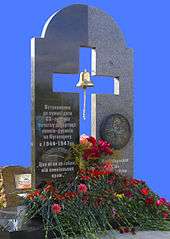
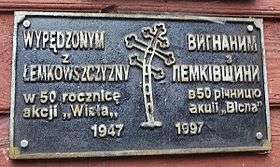
Several hypotheses account for the origin of the Hutsuls, however, like all the Rusyns, they most probably have a diverse ethnogenetic origin. The Lemkos (and other Carpatho-Rusyns) are considered to be descendants of the medieval White Croats,[9][10][11][12][13][14][15] affected by the migration of Ruthenian-influenced Slovaks[15] and the Vlach/Romanian migrations in the 14th and 15th centuries.[9][15][16]
Lemkivshchyna became part of Poland in medieval Piast times. Lemkos became an ethnic minority as part of the Austria province of Galicia in 1772.[17] Mass emigration from this territory to the Western hemisphere for economic reasons began in the late 19th century. After World War I, Lemkos founded two short-lived republics, the Lemko-Rusyn Republic in the west of Galicia, which had a russophile orientation, and the Komancza Republic, with a Ukrainophilic orientation.
It is estimated that about 130,000 to 140,000 Lemkos were living in the Polish part of Lemkivshchyna in 1939. Additional depopulation of these lands occurred during the forced resettlement, initially to the Soviet Union (about 90,000 people) and later to Poland's newly acquired western lands (about 35,000) in the Operation Vistula campaign of the late 1940s. This action was a state ordered removal of the civilian population, in a counter-insurgency operation to remove potential support for guerrilla war being waged by the Ukrainian Insurgent Army (UPA) in south-eastern Poland.
While a small number of Lemkos returned (some 5,000 Lemko families returned to their home regions in Poland between 1957–1958,[18] (they were officially granted the right to return in 1956), the Lemko population in the Polish section of Lemkivschyna only numbers around 10,000–15,000 today. Some 50,000 Lemkos live in the western and northern parts of Poland, where they were sent to populate former German villages in areas ceded to Poland. Among those, 5,863 people identified themselves as Lemko in the 2002 census. However, 60,000 ethnic Lemkos may reside in Poland today. Within Lemkivshchyna, Lemkos live in the villages of Łosie, Krynica-Zdrój, Nowica, Zdynia, Gładyszów, Hańczowa, Zyndranowa, Uście Gorlickie, Bartne, Binczarowa and Bielanka. Additional populations can be found in Mokre, Szczawne, Kulaszne, Rzepedź, Turzańsk, Komańcza, Sanok, Nowy Sącz, and Gorlice.
In 1968 an open-air museum dedicated to Lemko culture was opened in Zyndranowa. Additionally, a Lemko festival is held annually in Zdynia.
Religion
An important aspect of Lemko culture is their deep commitment to Eastern Christianity which was introduced to the Eastern Slavs from Byzantium via Moravia through the efforts of Saints Cyril and Methodius in the 9th century. Originally the Lemkos adhered to Orthodoxy, but in order to avoid latinization directly entered into union with Rome in the 17th century.
Most Lemkos today are Eastern rite or Byzantine-rite Catholics. In Poland they belong to the Ukrainian Greek Catholic Church with a Roman Catholic minority, or to the Ruthenian Catholic Church (see also Slovak Greek Catholic Church) in Slovakia. A substantial number belong to the Eastern Orthodox Church. Through the efforts of the martyred priest Fr. Maxim Sandovich (canonized by the Polish Orthodox Church in the 1990s), in the early 20th century, Eastern Orthodoxy was reintroduced to many Lemko areas which had accepted the Union of Brest centuries before.
The distinctive wooden architectural style of the Lemko churches (as opposed to their neighbouring sub-ethnic groups such as the Boikos) is to place the highest cupola of the church building at the entrance to the church, with the roof sloping downward toward the sanctuary.
Language
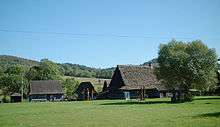
The Lemkos' language is considered by Ukrainian linguists to be the most western of Ukrainian dialects. The homeland occupied by the Lemkos has been influenced greatly by the languages spoken by neighboring or ruling peoples, so much so that some consider it a separate entity.[19]
Some scholars state that Lemko is the western-most dialect of the Rusyn language,[20][21] which in turn is considered by many Ukrainians to be a dialect of Ukrainian. Lemko speech includes some patterns matching those of the surrounding Polish and Slovak languages, leading some to refer to it as a transitional dialect between Polish and Slovak (some even consider the dialect in Eastern Slovakia to be a dialect of the Slovak language).
Metodyj Trochanovskij developed a Lemko Primer (Bukvar: Perša knyžečka dlja narodnŷch škol, 1935) and a First Reader (Druha knyžečka dlja narodnŷch škol, 1936) for use in schools in the Lemko-speaking area of Poland.[22] In 1934, Lemko was introduced as the language of instruction in schools in the Lemko region. The pupils were taught from textbooks prepared by Trochanovskij and published by the State Publishing House. However, shortly before the outbreak of World War II Polish authorities replaced them with Ukrainian texts.[23] Important fieldwork on the Lemko dialect was carried out by the Polish linguist Zdzisław Stieber before their dispersal.
According to the Central Statistical Office of Poland, in the school year 2010–2011, Lemko was taught as a first language in twenty primary schools and interschool groups, and ten schools and interschool groups at junior high level, with 188 students attending classes.[24]
In the late 20th century, some Lemkos/Rusyns, mainly emigres from the region of the southern slopes of the Carpathians in modern-day Slovakia, began codifying a standard grammar for the Lemko dialect, which was presented on the 27 January 1995 in Prešov, Slovakia. In 2013 the famous novel The Little Prince was translated into Lemko by Petro Krynyckij.[25]
Slovakia has more than 1,000,000 users of local dialects which would commonly use the word lem.
Lemkos in fiction
Nikolai Gogol's short story "The Terrible Vengeance" ends at Kriváň, now in Slovakia and pictured on the Slovakian euro, in the heart of Lemkivshchyna in the Prešov Region. Avram Davidson makes several references to the Lemko people in his stories.[26] Anna Bibko, mother-in-law of the protagonist of All Shall Be Well; and All Shall Be Well; and All Manner of Things Shall Be Well,[27] is a Lemko[28] "guided by her senses of traditionalism and grievance, not necessarily in that order".[29]
In the critically acclaimed movie The Deer Hunter the wedding reception scene was filmed in Lemko Hall in the Tremont neighborhood of Cleveland, Ohio, which had a significant immigrant population of Lemkos at one time.[30] The three main character's surnames, however, appear to be Russian (Michael "Mike" Vronsky, Steven Pushkov, and Nikonar "Nick" Chevotarevich) and the wedding took place in St. Theodosius Russian Orthodox Cathedral which is also located in Tremont.
Location
| Part of a series on |
| Ukrainians |
|---|
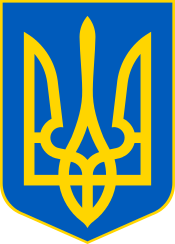 |
| Diaspora |
|
see Template:Ukrainian diaspora |
| Sub-national groups |
| Boikos · Hutsuls · Lemkos · Poleszuks |
| Closely-related peoples |
|
East Slavs (parent group) Rusyns · Poleszuks · Kuban Cossacks Pannonian Rusyns |
| Culture |
|
Architecture · Art · Cinema · Cuisine Dance · Language · Literature · Music Sport · Theater |
| Religion |
|
Eastern Orthodox (Moscow Patriarchate Orthodox Church of Ukraine) Greek Catholicism Roman Catholicism Judaism (among ethnic Jews) |
| Languages and dialects |
|
Ukrainian Russian · Canadian Ukrainian · Rusyn · Pannonian Rusyn Balachka · Surzhyk · Lemko |
|
History · Rulers List of Ukrainians |
The Lemkos' homeland is commonly referred to as Lemkivshchyna (Ukrainian: Лeмкiвщина, Lemko: Lemkovyna (Лeмкoвина), Polish: Łemkowszczyzna). Up until 1945, this included the area from the Poprad River in the west to the valley of Oslawa River in the east, areas situated primarily in present-day Poland, in the Lesser Poland and Subcarpathian Voivodeships (provinces). This part of the Carpathian mountains is mostly deforested, which allowed for an agrarian economy, alongside such traditional occupations as ox grazing and sheep herding.
The Lemko region became part of Poland in medieval Piast times. Lemkos were made part of the Austria province of Galicia in 1772.[17] This area was part of the Austro-Hungarian Empire until its dissolution in 1918, at which point the Lemko-Rusyn Republic (Ruska Lemkivska) declared its independence. Independence did not last long however, and the republic was incorporated into Poland in 1920.
As a result of the forcible deportation of Ukrainians from Poland to the Soviet Union after World War II, the majority of Lemkos in Poland were either resettled from their historic homeland to the prеviously German territories in the North-Western region of Poland or to the Ukrainian Soviet Socialist Republic.[31] Only those Lemkos living the Prešov Region in present-day Slovakia continue to live on their ancestral lands, with the exception of some Lemkos who resettled in their homeland in the late 1950s and afterward. Lemkos are/were neighbours with Slovaks, Carpathian Germans and Lachy sądeckie (Poles) to the west, Pogorzans (Poles) and Dolinians (a Rusyn subgroup) to the north, Ukrainians to the east, and Slovaks to the south.
 Ethnographic groups of southeasternmost Poland, Lemkos in light blue.
Ethnographic groups of southeasternmost Poland, Lemkos in light blue.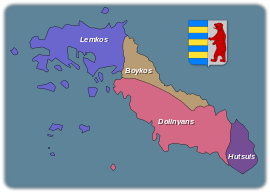 Highlander groups of westernmost Ukraine, Lemkos in blue.
Highlander groups of westernmost Ukraine, Lemkos in blue._-_1880_Podkarpacie.jpg) National map of languages (Outer Eastern Carpathians; Prešov Region; and Subcarpathian Voivodeship, 1876)
National map of languages (Outer Eastern Carpathians; Prešov Region; and Subcarpathian Voivodeship, 1876)_and_Przemy%C5%9Bl_area_Ukrainians_in_original_goral_folk-costumes..jpg)
Notable Lemkos
- Bohdan Ihor Antonych, poet
- Mary Beck, Detroit politician
- Thomas Bell, American novelist
- Emil Czyrniański, chemist
- Oleksandr Dukhnovych, writer
- Igor Herbut, musician
- Andrew Kay, inventor of the digital voltmeter (1953), and inductee of the Computer Hall of Fame for founding Kaypro Computer
- Ivan Krasovs'kyi, Lemko ethnographer/historian
- Volodymyr Kubiyovych, Ukrainian geographer
- Seman Madzelan, Lemko writer and activist
- Adrian Mikhalchishin, Ukrainian chessmaster
- Yuriy Mikhalchishin, Ukrainian politician, member of Ukrainian party Svoboda, son of Adrian Mikhalchishin
- Nikifor, painter
- Maxim Sandovich, Orthodox saint
- Andrij Savka aka Andrew Sawka, bandit, folk hero, Lemko "Robin Hood", led peasant revolution in 1651
- Khrystyna Soloviy, Ukrainian folk singer
- George Stroumboulopoulos, Canadian television personality with Ukrainian-born mother
- Petro Trochanowski, Lemko poet,[32] involved with contemporary Lemko issues
- Metodyj Trochanovskij, Lemko grammarian
- Andy Warhol (birth name Warhola), major figure in the pop art movement
- James Warhola, American artist
See also
- Besida
- Boyko
- Carpathian Ruthenia
- Green Ukraine republic
- History of Ukraine
- Hutsuls
- Lemko Republic
- Muzeum Budownictwa Ludowego w Sanoku
- Red Ruthenia
- Rusyn American
- Rusyn language
- Rusyns
- Ruthenia
- Ruthenians
- Shlakhtov Ruthenians
- Siberian Republic
- Ukraine
- Ukrainians
- White Croatia
References
- "Rusínska obroda na Slovensku pozitívne hodnotí výsledky Sčítania obyvateľstva 2011" [Rusyn Revival in Slovakia welcomes the results of population census 2011] (in Slovak). Ruthenian Revival in Slovakia. March 6, 2012. Archived from the original on July 6, 2013. Retrieved September 15, 2017.CS1 maint: unfit url (link)
- Przynależność narodowo-etniczna ludności – wyniki spisu ludności i mieszkań 2011. GUS. Materiał na konferencję prasową w dniu 29 January 2013. p. 3. Retrieved 2013-03-06.
- 2001 Census
- "Table 11. Resident population by nationality - 2001, 1991" (PDF). Statistical Office of the Slovak Republic. 2005. Archived from the original (PDF) on July 15, 2007. Retrieved September 15, 2017.
- European Charter for Regional or Minority Languages
- Jaroslav Rudnyckyj (1982). An Etymological Dictionary of the Ukrainian Language: Parts 12–22 (in English and Ukrainian). 2. Winnipeg: Ukrainian Free Academy of Sciences (UVAN). p. 770.
- Volodymyr Kubijovyč (2013) [1993]. "Hutsuls". Internet Encyclopedia of Ukraine. 3. University of Toronto Press. ISBN 978-0802039934.
The name seems to be derived from the frequent use of the word lem ‘only’ by the Lemkos. They usually call themselves rusnaky or rusyny (Ruthenians). Scholars and the intelligentsia began to use the name Lemko for the western groups of Ukrainian highlanders in the mid-19th century, and by the end of the century some Lemkos had accepted the name. It is not used widely in the Prešov region.
- Макар Ю.І. (2009). "ЛЕМКІВЩИНА". Encyclopedia of Ukrainian History (in Ukrainian). 6. Naukova Dumka, NASU Institute of History of Ukraine. ISBN 978-966-00-1028-1.
Вважається, що назва "Лемківщина" походить від слова "лем", яке в лемківській говірці означає "лише". Самі ж лемки називали себе "русинами", або "руснаками". Ця власна назва є тамтешньою власною назвою українців, вона зберігалася ще в 19 ст. в Галичині, а у 20 ст. – на Підляшші, Холмщині, Л., Закарпатській Україні і серед українців ін.
CS1 maint: ignored ISBN errors (link) - Magocsi, Paul Robert (1995). "The Carpatho-Rusyns". Carpatho-Rusyn American. XVIII (4).
The purpose of this somewhat extended discussion of early history is to emphasize the complex origins of the Carpatho-Rusyns. They were not, as is often asserted, exclusively associated with Kievan Rus', from which it is said their name Rusyn derives. Rather, the ancestors of the present-day Carpatho-Rusyns are descendants of: (1) early Slavic peoples who came to the Danubian Basin with the Huns; (2) the White Croats; (3) the Rusyns of Galicia and Podolia; and (4) the Vlachs of Transylvania.
- Magocsi, Paul R. (30 July 2005). Our people: Carpatho-Rusyns and their descendants in North America. Bolchazy-Carducci Publishers. p. 5. ISBN 9780865166110.
- Majorov, Aleksandr Vjačeslavovič (2012), Velika Hrvatska: etnogeneza i rana povijest Slavena prikarpatskoga područja [Great Croatia: ethnogenesis and early history of Slavs in the Carpathian area] (in Croatian), Zagreb, Samobor: Brethren of the Croatian Dragon, Meridijani, ISBN 978-953-6928-26-2
- Magocsi, Paul Robert (2015). With Their Backs to the Mountains: A History of Carpathian Rus? and Carpatho-Rusyns. Central European University Press. p. 29. ISBN 978-615-5053-46-7.
- Katchanovski, Ivan; Kohut, Zenon E.; Nebesio, Bohdan Y.; Yurkevich, Myroslav (2013). Historical Dictionary of Ukraine. Scarecrow Press. p. 321. ISBN 978-0-8108-7847-1.
In the opinion of some scholars, the ancestors of the Lemkos were the White Croatians, who settled the Carpathian region between the seventh and tenth centuries.
- И. А. Бойко (2016). "ЛЕ́МКИ". Great Russian Encyclopedia (in Russian). Bolshaya Rossiyskaya Entsiklopediya, Russian Academy of Sciences.
Сформировались к 17 в. на основе потомков историч. хорватов и укр. переселенцев (в т. ч. пленных запорожских казаков) при влиянии вост.
- "Wooden Tserkvas of the Carpathian Region in Poland and Ukraine" (PDF) (Press release). Warsaw – Kiev. UNESCO. 2011. p. 9. Retrieved 2020-08-03.
The Lemkos an ethnic group inhabiting the Eastern Carpathians, between the River of Poprad to the west and the rivers of Oslava and Laborec to the east. The ethnic shape of the Lemko territory was affected by the Wallachian colonization in 14th-16th centuries, the influx of a Ruthenian-influenced Slovak population and the settlement of a Slavic tribe called the White Croats, who had inhabited this part of the Carpathians since the 5th century.
- Ewa Kocój (2015). "Heritage without heirs? Tangible and religious cultural heritage of the Vlach minority in Europe in the context of an interdisciplinary research project". Balcanica Posnaniensia Acta et Studia. Baner. Jagiellonian University, Faculty of Management and Social Communication, Kraków, Poland. 22 (1): 141–142.
The prevailing religion among Lemkos and Boykos, who are the representatives of the Vlach minority in Poland, Slovakia and Ukraine, includes the Orthodox faith and then the Greek Catholic Church ... Hutsuls, who inhabit the south-west of Ukraine (Chornohora) and the north of Romania, are mostly Orthodox and, to a much lesser extent, Greek Catholics
- Levinson, David (1994). Levinson, David; Diamond, Norma (eds.). Encyclopedia of World Cultures: Russia and Eurasia, China. Encyclopedia of World Cultures. 6. Boston, Massachusetts: G.K. Hall. p. 69. ISBN 978-0-8161-1810-6.
- Lemko Republic of Florynka / Ruska narodna respublika Lemkiv
- See uk:Лемківський говір
- "The Rusyns". Rusyn. Archived from the original on 2008-05-09. Retrieved 2013-03-26.
- Best, Paul Joseph; Moklak, Jarosław, eds. (2000). The Lemkos of Poland : articles and essays. Carpatho-Slavic Studies. 1–3. New Haven, Cracow: Carpatho-Slavic Studies Group, Historia Iagellonica Press. ISBN 978-83-912018-3-1. OCLC 231621583.
- Horbal, Bogdan (2005). "The Rusyn Movement among the Galician Lemkos" (PDF). In Custer, Richard D. (ed.). Rusyn-American Almanac of the Carpatho-Rusyn Society 10th Anniversary 2004–2005. Pittsburgh, Pennsylvania. pp. 81–91.
- Duć-Fajfer, Helena. "Szkolnictwo na Łemkowszczyźnie (Schooling in the Lemko region)". revitalization.al.uw.edu.pl (in Polish). University of Warsaw. Retrieved 2 June 2018.
- Hornsby, Michael (2015). Revitalizing Minority Languages: New Speakers of Breton, Yiddish and Lemko. Palgrave Macmillan. p. 97. ISBN 978-1-137-49880-9.
- Little Prince nr. PP-2812 / Lemkovian (petit-prince-collection.com)
- Davidson, Avram (2001-12-20). "The Odd Old Bird". In Davis, Grania; Wessells, Henry (eds.). The Other Nineteenth Century. p. 125. ISBN 978-0-312-84874-3. OCLC 48249248.
Lemkovarna, the land of the Lemkos, those Slavs forgotten by everyone save themselves
- Wodicka, Tod (2007). All Shall Be Well; and All Shall Be Well; and All Manner of Things Shall Be Well. New York: Pantheon Books. ISBN 978-0-375-42473-1. OCLC 124165798.
- Nicholas Lezard (28 June 2008). "Sympathy for the outsider" (book review). The Guardian. Retrieved 23 December 2009.
(You could be forgiven for thinking Wodicka has made the Lemkos up. He hasn't.)
- Janet Maslin (24 January 2008). "Mead-Drinking, Gruel-Eating, Sandal-Wearing, Reality-Fleeing Family Guy". New York Times. Retrieved 12 December 2009.
- "Lemko Hall".
- Kordan B (1997). "Making borders stick: population transfer and resettlement in the Trans-Curzon territories, 1944–1949". The International Migration Review. 31 (3): 704–20. doi:10.2307/2547293. JSTOR 2547293. PMID 12292959.
- Mihalasky, Susyn Y (1997). "A Select Bibliography of Polish Press Writing on the Lemko Question". Retrieved 13 December 2009.
Further reading
- Moklak, Jaroslaw. The Lemko Region in the Second Polish Republic: Political and Interdenominational Issues 1918--1939 (2013); covers Old Rusyns, Moscophiles and National Movement Activists, & the political role of the Greek Catholic and Orthodox Churches
- Łemkowie Grupa Etniczna czy Naród?, [The Lemkos: An Ethnic Group or a Nation?], trans. Paul Best
- The Lemkos of Poland – Articles and Essays, editor Paul Best and Jarosław Moklak
- The Lemko Region, 1939–1947 War, Occupation and Deportation – Articles and Essays, editor Paul Best and Jarosław Moklak
- Horbal, Bogdan (April 30, 2010). Lemko Studies: A Handbook. East European Monographs. ISBN 978-0-88033-639-0. OCLC 286518760.
- Laun, Karen (6 December 1999). "A Fractured Identity: The Lemko of Poland". Central Europe Review. 1 (24).
- Лемкiвскiй календар. (Lemkivskiĭ kalendar)
- Madzelan, Seman (1986). Smak doli [Taste of fate] (in Polish). Nowy Sącz. OCLC 28484749.
- Madzelan, Vasil; Madzelan, Seman (1993). Lemkivshchyna, a Ukrainian Ethnic Group (in Rusyn). Lviv.
- Drozd R., Halczak B. Dzieje Ukraińców w Polsce w latach 1921–1989 / Roman Drozd, Bohdan Halczak. – wyd. II, poprawione. – Warszawa : TYRSA, 2010. – 237 s.
- Halczak B. Publicystyka narodowo – demokratyczna wobec problemów narodowościowych i etnicznych II Rzeczypospolitej / Bohdan Halczak. – Zielona Góra : Wydaw. WSP im. Tadeusza Kotarbińskiego, 2000. – 222 s.
- Halczak B. Problemy tożsamości narodowej Łemków / Bohdan Halczak // W: Łemkowie, Bojkowie, Rusini: historia, współczesność, kultura materialna i duchowa / red. nauk. Stefan Dudra, Bohdan Halczak, Andrzej Ksenicz, Jerzy Starzyński . – Legnica – Zielona Góra : Łemkowski Zespół Pieśni i Tańca "Kyczera", 2007 – s. 41–55 .
- Halczak B. Łemkowskie miejsce we wszechświecie. Refleksje o położeniu Łemków na przełomie XX i XXI wieku / Bohdan Halczak // W: Łemkowie, Bojkowie, Rusini – historia, współczesność, kultura materialna i duchowa / red. nauk. Stefan Dudra, Bohdan Halczak, Roman Drozd, Iryna Betko, Michal Šmigeľ . Tom IV, cz. 1 . – Słupsk – Zielona Góra : [b. w.], 2012 – s. 119–133 .
- Дрозд Р., Гальчак Б. Історія українців у Польщі в 1921–1989 роках / Роман Дрозд, Богдан Гальчак, Ірина Мусієнко; пер. з пол. І. Мусієнко. 3-тє вид., випр., допов. – Харків : Золоті сторінки, 2013. – 272 с.
- Andrzej A. Zięba (1997). Łemkowie i łemkoznawstwo w Polsce. Nakł. Polskiej Akademii Umiejętności. ISBN 978-83-86956-29-6.
- Małgorzata Misiak (2006). Łemkowie: w kręgu badań nad mniejszościami etnolingwistycznymi w Europie. Wydawnictwo Uniwersytetu Wrocławskiego. ISBN 978-83-229-2743-4.
- Polskie Towarzystwo Turystyczno-Krajoznawcze. Zarząd Główny. Komisja Turystyki Górskie.̊ (1987). Łemkowie, kultura, sztuka, język: materiały z symposjum zorganizowanego przez komisję turystyki górskiej ZG PTTK Sanok, DN. 21-24 Września 1983 r. Wydawnictwo PTTK "Kraj".
- Andrzej Kwilecki (1974). Łemkowie: zagadnienie migracji i asymilacji. Państwowe Wydawn. Naukowe.
- Muzeum Narodowe Rolnictwa i Przemysłu Rolno-Spożywczego (Szreniawa). (2007). Łemkowie: historia i kultura : sesja naukowa Szreniawa, 30 czerwca - 1 lipca 2007. Muzeum Narodowe Rolnictwa i Przemysłu Rolno-Spożywczego w Szreniawie. ISBN 978-83-86624-58-4.
- Jarosław Zwoliński (1996). Łemkowie w obronie własnej: zdarzenia, fakty, tragedie : wspomnienia z Podkarpacia. J. Zwoliński.
- Ewa Michna (1 January 1995). Łemkowie: grupa etniczna czy naród?. Zakład Wydawniczy "Nomos". ISBN 978-83-85527-27-5.
- Roman Reinfuss (1936). Łemkowie: (opis etnograficzny). Druk W. L. Anczyca.
- Tadeusz Zagórzański; Andrzej Wielocha (1984). Łemkowie i Łemkowszczyzna: materiały do bibliografii. SKPB.
- Patrycja Trzeszczyńska, "Bridges to the past: a Lemko family history explored through letters. An ethnographic case study," Canadian Slavonic Papers 60, no. 1-2 (2018)
External links
| Wikimedia Commons has media related to Lemkos. |
- Lemko Portal in Ukraine
- Canadian Lemko Association
- Lemko revival in Poland
- The Zarzad Glowny Zjednoczenia Lemkow w Polsce (Lemko-Ukrainian Union in Poland)
- Lemko.org
- Stowarzyszenie Łemków (Association of Lemkos)
- Lemko Portal in Lviv
- "The Lemko Project" - A blog and resource site about Lemko history, culture and events. English language.
- Ukraine Lemko ethno folk group
- "The bells of Lemkivshchyna. Will the authorities of Ukraine and Poland listen to them", Zerkalo Nedeli, (Mirror Weekly), May 25–31, 2002. Available online in Russian and in Ukrainian.
- "Five questions for a Lemko", Zerkalo Nedeli, (Mirror Weekly), January 19–25, 2002. Available online in Russian and in Ukrainian.
- Metodyj Trochanovskij
- Lemko Portal in Poland
